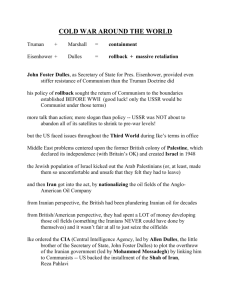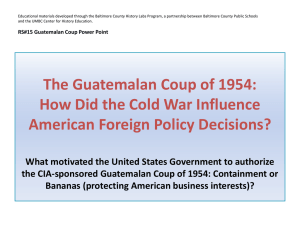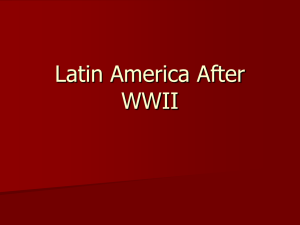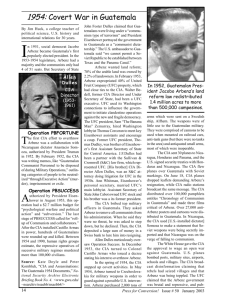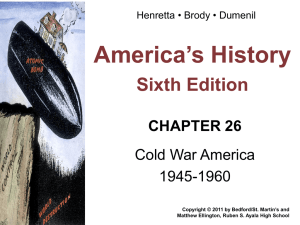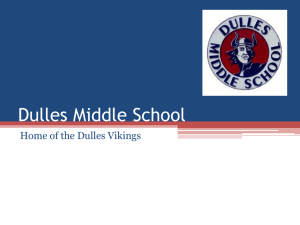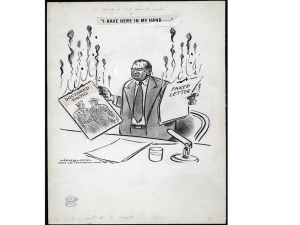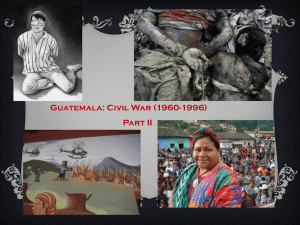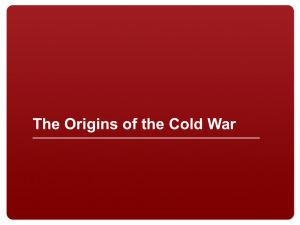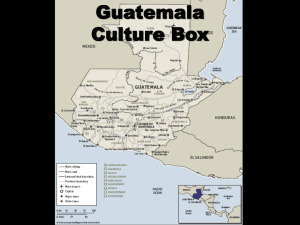Cold War in the Americas
advertisement
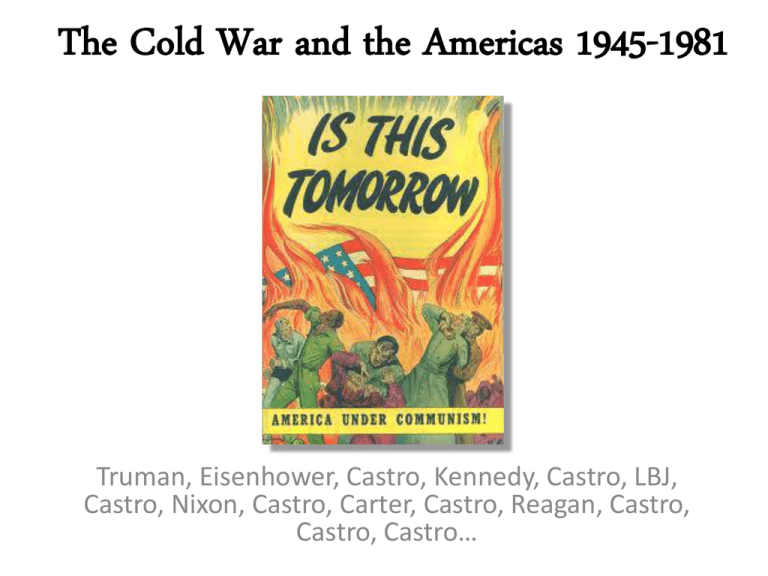
The Cold War and the Americas 1945-1981 Truman, Eisenhower, Castro, Kennedy, Castro, LBJ, Castro, Nixon, Castro, Carter, Castro, Reagan, Castro, Castro, Castro… Questions to Consider • Was U.S. Latin American policy guided by ideology or economic interest? • Assess the policies of President Truman, containment and its implication for the Americas. • Review the policies of President Eisenhower and U.S. Secretary of State John Foster Dulles: the reasons for the New Look and its repercussions in the region. • Evaluate the foreign policies of presidents Kennedy to Carter, the characteristics and reasons behind policies. • Understand the effects of the Cold War in Chile. Harry Truman 1945-1953 • Democrat • First U.S. Cold War president • Truman Doctrine, Containment • Hands full with Europe and Asia • Latin American policy emphasis on keeping commies out of the region Truman 1945-1953 • Latin American leaders expected continued U.S. support of Good Neighbor Policy in return for their support to the U.S. during WWII – Reciprocal Trade Agreements – Nonintervention – Economic support (Marshall Plan for Latin America • Pan- American (Regional) Conferences – L.A. leaders emphasis on economic development, U.S. emphasis on anti-communism and national security – Act of Chapultepec (1946) self determination, sovereignty – Rio Treaty (1947) – mutual defense for American states Truman 1945-1953 • Truman admin. Interprets Rio Treaty as extension of containment policy, positive U.S.–L.A. relations based on being anti-communism – 1947, U.S. pressures Brazil, Chile, Cuba to ban communist organizations and break diplomatic relations with USSR – “Compulsory, automatic (Cold War) allies of the U.S.” – Many in Latin America saw Rio as a return to pre-Good Neighbor • School of the Americas – Established 1945 by US in Panama to train LA military units – National Guard units in Central America used to protect dictatorships in Central America (Nicaragua, El Salvador, Dominican Republic ) Truman 1945-1953 • Organization of American States (OAS) – Formalization of regional defense pact – Once again administration emphasis on Cold War defense and anti-communist pledges (in spite of State Dept calls for security through economic development) • Truman’s 1949 Inaugural Address “Four Point Program” – Point Four- scientific, technical and financial aid to the developing world. – Less 3% of US aid goes to Latin American states – Louis Halle (US State Dept) Mr. Y Foreign Affairs Truman 1945-1953 • Bolivia – 1952 Revolution – Election won by left-leaning Victor Estenssoro, (land reform, universal suffrage) – Truman refuses recognition of Estenssoro government • NSC-141 – “seek first..orderly political and economic development which will make LA nations resistant to internal growth of communism and Soviet political warfare.” – “seek hemispheric solidarity in support of our world policy.” Dwight D. Eisenhower 1953-1961 • Republican • Hands full with budget deficits • New Look, Domino Theory • CIA covert operations • Guatemala, Cuba • The Dulles brothers Ike 1953-1961 • National Security Act 1947, creation of Central Intelligence Agency (CIA) – Collect intelligence and data on foreign governments – Section 102 cl. 5 “fifth function” …to perform other functions and duties related to intelligence affecting the national security as the NSC may from time to time direct.. – Eisenhower under advice of Sec. of State John Foster Dulles and CIA director Allen Dulles used covert ops in Iran, Guatemala and planned action for Cuba – Plausible deniability Ike 1953-1961 • New Look – Shift in military budget from large army and navy to building the air force and nuclear stockpile. – More bang for the buck. 1953= 1,200 nukes, 1961=22,000 – USSR building its own stockpile since 1949 – Mutually Assured Destruction (MAD) – Brinksmanship – John Foster Dulles’ moral crusade against communism, shift from mere containment to freeing oppressed peoples of the world (Guatemala, Vietnam) – Growing reliance on CIA covert operations (cheap, fast, deniable) Ike 1953-1961 • New Look in Canada – North Amercan Aerospace Defense Command (NORAD) 1958 – Early warning system of potential Soviet air raid (bombers and missiles) – Preemptive move by Canadian government Ike 1953-1961 • New Look in Latin America – John Foster Dulles, communism on the rise in Latin America – Domino Theory (his proof, China) • Hindsight is 20/20 – U.S. perceives everything through pinko Cold War glasses – Leftist leaders in LA may have had Marxist ideas but did not support Stalin or his methods – Land reform was a major political/economic issue in LA. More about nationalism than communism • Haciendas and plantations • Ejido • United Fruit Company (el pulpo) Ike, The Dulles Brothers & Guatemala • United Fruit Co.(UFCO) – US company est.1889. Invest in LA, cheap land, labor and taxes = big profits – Invest in railroads and ports to support exports – LA dictators (ex. Jorge Ubico) welcome UFCO investment with low taxes, antiunion policies, and national guard troops – UFCO amasses millions of acres of prime growing land but only cultivates 15% of its holdings Ike, The Dulles Brothers & Guatemala • First Democratic Elections in Guatemala 1945 – Jacobo Arbenz campaigns as a left leaning reformer, becomes president in 1951 • Agrarian Reform Bill/Decree 900 – Expropriation of uncultivated land – Purchased at tax value, paid for with sale of bonds – 1.5 million acres redistributed to 100,000 families – UFCO refused Guatemalan gov. offer, US State Dept intervenes on behalf of UFCO – Dulles connection Ike, The Dulles Brothers & Guatemala • US (Dulles Bros.) see Arbenz as a communist – Pressures Organization of American States (OAS)to issue Caracas Declaration (1945) in which member states vow to stop Marxist influence within their governments. – US declares an embargo on Guatemala • Operation PBSUCCESS – CIA covert operation to overthrow Arbenz – Arbenz fearful of a coup requests arms sales from US (unaware that the CIA is behind coup) – US refuses arms sales, Arbenz seeks weapons from Poland (Soviet Satellite state) – US uses arms sale as proof that Arbenz is communist Ike, The Dulles Brothers & Guatemala • The Coup – Honduras base of operation, CIA funds a small army led by exiled General Castillo Armas – Ahead of Armas CIA launches psyops: radio broadcasts of false troop movements, CIA pilots in false marked aircraft buzz Guatemala City – Panic ensues, Guatemalan army refuses to fight – Arbenz resigns an goes into exile Ike, The Dulles Brothers & Guatemala • The Coup Aftermath – Armas is installed as the new president and reverses Decree 900, restoring all expropriated land to UFCO – Operation PBHISTORY – Armas marks the beginning of a string of brutal dictators to rule Guatemala until 1999. – Today, Guatemala is poorest state in Central America Glorious Victory artist Diego Rivera Vice-Pres. Nixon Visits Latin America • May 1958 Ike sends Nixon to LA – Shocked by widespread antiUS protests (students) – Caracas and Lima students turn violent – US State Dept blames communists agitators – Nixon urges Ike increase economic aid to LA – US recession and deficit spending force Ike to cut economic aid to LA Revolucion • July 26th, 1953: Fidel Castro and 160 rebels are defeated in their attack on the Moncada army barracks in attempt to overthrow dictator Fulgencio Batista • Fidel and brother Raul are arrested and sentenced to 15 yrs. prison, only to be released in 1955. • Castro bros. meet Ernesto “Che” Guevara in Mexico, organize the 26th July Movement, and launch another attack in 1958. • Castro’s revolutionary army retreats to Sierra Maestra & builds peasant support for the revolution. • Eisenhower cuts ties with Batista and embargoes arms shipments to Cuban government (Why?) Post-Revolution 1959-1960 • Castro begins to purge the military and police of Batista loyalists • While visiting the U.S., Castro says "I know the world thinks of us, we are Communists, and of course I have said very clear that we are not Communists; very clear." • Eisenhower officially recognizes Castro’s post-revolution Cuban government. Post-Revolution Period 1959-1960 • U.S. concerned by Cuban agrarian reforms including redistribution of land, tries to pressure Cuba economically by cutting Cuba’s sugar imports and oil exports from the U.S. to Cuba • March 1960, the Le Coubre explodes in Havana harbor. (sound familiar) • March 1960: Eisenhower authorizes the CIA to recruit and train Cuban exiles to overthrow Castro. • October 1960: U.S. imposes trade embargo. So, Cuba began to open trade relations with the Soviet Union. • January 3, 1961: US withdrew diplomatic recognition of the Cuban government and closed the embassy in Havana • Kennedy is elected president Nov. 1960 More to Come…
